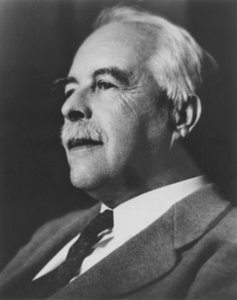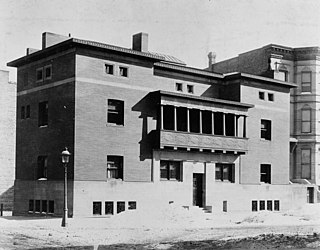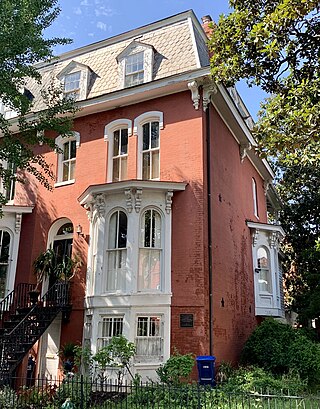
Gilbert Newton Lewis was an American physical chemist and a dean of the college of chemistry at University of California, Berkeley. Lewis was best known for his discovery of the covalent bond and his concept of electron pairs; his Lewis dot structures and other contributions to valence bond theory have shaped modern theories of chemical bonding. Lewis successfully contributed to chemical thermodynamics, photochemistry, and isotope separation, and is also known for his concept of acids and bases. Lewis also researched on relativity and quantum physics, and in 1926 he coined the term "photon" for the smallest unit of radiant energy.

Theodore William Richards was an American physical chemist and the first American scientist to receive the Nobel Prize in Chemistry, earning the award "in recognition of his exact determinations of the atomic weights of a large number of the chemical elements."

The James Charnley Residence, also known as the Charnley-Persky House, is a historic house museum at 1365 North Astor Street in the near northside Gold Coast neighborhood of Chicago, Illinois. Designed in 1891 and completed in 1892, it is one of the few surviving residential works of Adler & Sullivan.

The George Herbert Jones Laboratory is an academic building at 5747 S. Ellis Avenue, Chicago, Illinois, on the main campus of the University of Chicago. Room 405 of the building was named a National Historic Landmark in 1967; it was the site where plutonium, the first man-made element, was isolated and measured.

The Zalmon Richards House is a historic house in Washington, D.C. A Second Empire rowhouse, it was home from 1882 until his death of Zalmon Richards (1811–1899), founder of the National Education Association. It was declared a National Historic Landmark in 1965. It is a private residence.

The McLellan-Sweat Mansion is a historic house museum on High Street in Portland, Maine. It forms the rear component of the Portland Museum of Art complex. Built in 1800–01, the house was designated a National Historic Landmark in 1970 as a well-preserved Federal style brick townhouse.

The Edwin Arlington Robinson House is an historic house at 67 Lincoln Avenue in Gardiner, Maine. A two-story wood-frame house, it was designated a National Historic Landmark in 1971 for its association with Edwin Arlington Robinson (1869–1935) one the United States' leading poets of the late 19th and early 20th centuries.

The Joseph Story House is a historic house facing the Salem Common in Salem, Massachusetts. Built in 1811, this house was home from then until his death of United States Supreme Court Associate Justice Joseph Story (1779–1845), a leading jurist of the time, and an influential figure in the early years of Harvard Law School. A well-preserved example of Federal architecture executed in brick, it is a National Historic Landmark.

The Francis Parkman House is a National Historic Landmark at 50 Chestnut Street, on Beacon Hill in Boston, Massachusetts. Speculated to be designed by Cornelius Coolidge and built in 1824, it is one of a series of fine brick townhouses on Beacon Hill. Its significance lies in its ownership and occupancy by noted historian and horticulturalist Francis Parkman (1823–1893) from 1865 until his death. While living here, Parkman produced a significant portion of his landmark work, France and England in North America, a multi-volume epic history recounting the conflict for control of North America in the 17th and 18th centuries.

The Samuel Gridley and Julia Ward Howe House is a historic rowhouse at 13 Chestnut Street in the Beacon Hill neighborhood of Boston, Massachusetts, United States. It was designated a National Historic Landmark in 1974 for its association with the social reform couple, Julia Ward Howe and Samuel Gridley Howe. The Howes lived in the house, which was likely designed by renowned Boston architect Charles Bulfinch, from 1863 to 1866. It has served as the temporary official residence of the British Consul General to New England since 2016.

Hamilton Hall is a National Historic Landmark at 9 Chestnut Street in Salem, Massachusetts. Designed by noted Salem builder Samuel McIntire and built in 1805–1807, it is an excellent instance of a public Federal style building. It was built as a social space for the leading families of Salem, and was named for Founding Father and Federalist Party leader Alexander Hamilton. It continues to function as a social hall today: it is used for events, private functions, weddings and is also home to a series of lectures that originated in 1944 by the Ladies Committee.

The Mary Fiske Stoughton House is a National Historic Landmark house at 90 Brattle Street in Cambridge, Massachusetts. Henry Hobson Richardson designed the house in 1882 in what is now called the Shingle Style, with a minimum of ornament and shingles stretching over the building's irregular volumes like a skin. The house drew immediate notice in the architectural community, and was a significant influence in the growth in popularity of the Shingle style in the late 19th century. Richardson's masterful use of space in its design also foreshadowed the work of major 20th century architects, including Frank Lloyd Wright. The house was designated a National Historic Landmark in 1989.

The Nathan and Mary (Polly) Johnson properties are a National Historic Landmark at 17–19 and 21 Seventh Street in New Bedford, Massachusetts. Originally the building consisted of two structures, one dating to the 1820s and an 1857 house joined with the older one shortly after construction. They have since been restored and now house the New Bedford Historical Society. The two properties are significant for their association with leading members of the abolitionist movement in Massachusetts, and as the only surviving residence in New Bedford of Frederick Douglass. Nathan and Polly Johnson were free African-Americans who are known to have sheltered escaped slaves using the Underground Railroad from 1822 on. Both were also successful in local business; Nathan as a caterer and Polly as a confectioner.

The George R. Minot House is a National Historic Landmark in Brookline, Massachusetts. It is an architecturally undistinguished vernacular Colonial Revival brick house, probably built in the 1920s. The 2+1⁄2-story main block has an attached 1+1⁄2-story ell, and two end chimneys. The hip roof is pierced by gabled dormers, and a pedimented portico shelters the front entry.

The Bacon-Gleason-Blodgett Homestead is a historic house at 118 Wilson Road in Bedford, Massachusetts. Built about 1740, it is the town's only surviving example of a brick-end colonial-period house, with long association to a nearby gristmill. The house was listed on the National Register of Historic Places on April 14, 1977, and included in the Wilson Mill-Old Burlington Road District on August 18, 2003.

The Helen Newberry Nurses Home is a multi-unit residential building located at 100 East Willis Avenue in Midtown Detroit, Michigan. It was listed on the National Register of Historic Places in 2008, and is now the Newberry Hall Apartments.

The United States Customhouse is a historic and active custom house at 2nd and William Streets in New Bedford, Massachusetts. Architect Robert Mills designed the custom house in 1834 in a Greek Revival style. It has been used by the U.S. Customs Service ever since, and today serves as a port of entry.

The Commission on Isotopic Abundances and Atomic Weights (CIAAW) is an international scientific committee of the International Union of Pure and Applied Chemistry (IUPAC) under its Division of Inorganic Chemistry. Since 1899, it is entrusted with periodic critical evaluation of atomic weights of chemical elements and other cognate data, such as the isotopic composition of elements. The biennial CIAAW Standard Atomic Weights are accepted as the authoritative source in science and appear worldwide on the periodic table wall charts.

Gregory Paul Baxter was an American chemist notable for his work on atomic weights.

The Robinson and Swan Blocks are a pair of mixed commercial-residential buildings at 104-108 Pleasant Street and 1-3 Irving Street in Worcester, Massachusetts. Built about 1884 to nearly identical designs by Fuller & Delano, the buildings are well-preserved examples of Victorian Gothic architecture executed in brick. They were listed on the National Register of Historic Places in 1980, but due to administrative lapses, are not listed in its NRIS database.























